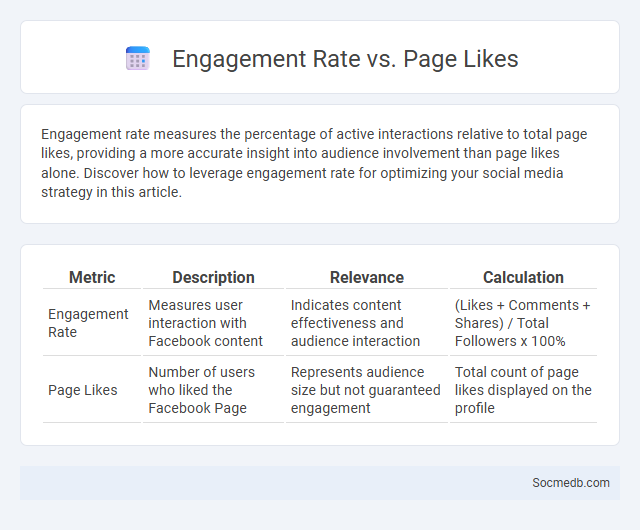
Photo illustration: Engagement Rate vs Page Likes
Engagement rate measures the percentage of active interactions relative to total page likes, providing a more accurate insight into audience involvement than page likes alone. Discover how to leverage engagement rate for optimizing your social media strategy in this article.
Table of Comparison
| Metric | Description | Relevance | Calculation |
|---|---|---|---|
| Engagement Rate | Measures user interaction with Facebook content | Indicates content effectiveness and audience interaction | (Likes + Comments + Shares) / Total Followers x 100% |
| Page Likes | Number of users who liked the Facebook Page | Represents audience size but not guaranteed engagement | Total count of page likes displayed on the profile |
Understanding Engagement Rate: Definition and Importance
Engagement rate measures the level of interaction your content receives from followers, including likes, comments, shares, and clicks, relative to your total audience size. This metric is crucial for evaluating the effectiveness of your social media strategy and identifying content that resonates with your target audience. Understanding your engagement rate enables you to optimize posts for higher visibility and stronger community connection.
What Are Page Likes? A Brief Overview
Page likes on social media represent users' positive interactions and signify their interest or support for a brand, business, or public figure's page. These likes increase the page's visibility and credibility, influencing the platform's algorithm to boost content reach. High page likes often correlate with greater audience engagement, expanding the potential for marketing and community growth.
Engagement Rate vs Page Likes: Key Differences
Engagement rate measures the level of interaction your social media content receives, including likes, comments, shares, and clicks, while page likes represent the total number of users who have followed or liked your page. Focusing on engagement rate provides deeper insights into how actively your audience connects with your content, indicating content relevance and effectiveness. Your strategy should prioritize enhancing engagement rather than solely increasing page likes to build a loyal and interactive community.
How Engagement Rate Is Calculated
Engagement rate is calculated by dividing the total number of interactions a social media post receives--such as likes, comments, shares, and clicks--by the total number of followers or impressions, then multiplying by 100 to express it as a percentage. This metric provides insight into how actively an audience interacts with content, reflecting post effectiveness and audience interest. Analyzing engagement rates helps marketers optimize social media strategies and measure campaign performance across platforms like Instagram, Facebook, and Twitter.
Why Page Likes Alone Don’t Tell the Whole Story
Page likes on social media provide a superficial metric that fails to capture true audience engagement and content impact. Metrics such as comments, shares, click-through rates, and time spent on posts offer deeper insights into user interaction and brand loyalty. Relying solely on page likes can mislead marketers about the effectiveness of their social media strategies and audience connection.
The True Value of High Engagement Rates
High engagement rates on social media indicate authentic interactions, fostering stronger brand loyalty and trust among followers. Platforms prioritize content with higher engagement, increasing organic reach and amplifying marketing effectiveness. Brands leveraging these interactions gain valuable insights into audience preferences, enhancing targeted campaigns and customer satisfaction.
Which Metric Matters Most for Your Brand Goals?
Engagement rate stands as the most crucial metric for your brand goals because it directly reflects how your audience interacts with your content, indicating genuine interest and loyalty. Metrics like reach or follower count provide surface-level data but don't measure the quality of connections that drive conversions and brand advocacy. Prioritizing engagement offers actionable insights for optimizing content strategies and accelerating growth tailored to your brand's unique objectives.
Strategies to Improve Engagement Rate
Effective social media strategies to improve engagement rate include creating compelling, audience-specific content that encourages interaction, such as polls, questions, and user-generated posts. Consistent posting schedules combined with real-time responses to comments and messages foster community loyalty and boost algorithmic visibility. Leveraging platform analytics to identify peak activity times and content preferences optimizes reach and user engagement.
Common Misconceptions About Engagement and Likes
Many users mistakenly equate high engagement and numerous likes with guaranteed social media success, overlooking the importance of audience relevance and content quality. Engagement metrics can be artificially inflated through bots or paid interactions, which do not translate to genuine user interest or conversions. Understanding the nuanced relationship between organic engagement, follower authenticity, and meaningful metrics is crucial for effective social media strategy.
Choosing the Right Social Media Metric for Success
Selecting the right social media metric is crucial for measuring the success of your campaigns and achieving your business goals. Focus on engagement rates, such as likes, comments, and shares, to gauge audience interaction and brand resonance effectively. Tracking conversion metrics, including click-through rates and sales generated from social media, provides a clear picture of your return on investment and overall impact.
 socmedb.com
socmedb.com